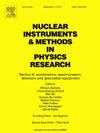瑞士机载伽玛射线能谱系统的高保真全谱蒙特卡罗模型的开发和验证
IF 1.5
3区 物理与天体物理
Q3 INSTRUMENTS & INSTRUMENTATION
Nuclear Instruments & Methods in Physics Research Section A-accelerators Spectrometers Detectors and Associated Equipment
Pub Date : 2025-04-15
DOI:10.1016/j.nima.2025.170512
引用次数: 0
摘要
机载伽玛射线能谱法(AGRS)是辐射应急反应的关键工具,能够快速识别和量化大面积的危险陆地放射性核素。然而,现有的校准方法仅限于少数伽玛射线源,不包括在严重核事故和核武器爆炸中释放的大多数放射性核素,这影响了对此类事件的有效反应和准确的风险评估。在这里,我们提出了一种高保真蒙特卡罗模型,克服了这些限制,为任何伽玛射线源提供全光谱校准。与以前的方法不同,我们的模型集成了飞机的详细质量模型和校准的非比例闪烁模型,从而能够准确地预测光谱仪对任意复杂伽马射线场的响应。近场、中场和远场场景的验证测量表明,所开发的模型不仅有效地解决了以前方法的巨大缺陷,而且达到了取代传统经验校准方法所需的准确度和精度。这些结果标志着AGRS的重大进展。开发的校准方法不仅允许为任何伽玛射线源生成高保真光谱特征,而且还减少了校准时间和成本,最大限度地减少了对高强度校准源的依赖,并消除了相关放射性废物的产生。本文提出的方法是整合先进的AGRS全谱数据缩减方法的关键一步,它可以为这些系统提供除应急响应之外的有希望的新功能,包括用于地球物理研究的大气宇宙射线通量的量化和核安全应用中痕量空气传播放射性核素的识别。本文章由计算机程序翻译,如有差异,请以英文原文为准。
Development and validation of a high-fidelity full-spectrum Monte Carlo model for the Swiss airborne gamma-ray spectrometry system
Airborne Gamma-Ray Spectrometry (AGRS) is a critical tool for radiological emergency response, enabling the rapid identification and quantification of hazardous terrestrial radionuclides over large areas. However, existing calibration methods are limited to only a few gamma-ray sources, excluding most radionuclides released in severe nuclear accidents and nuclear weapon detonations, which compromises effective response and accurate risk assessments in such incidents. Here, we present a high-fidelity Monte Carlo model that overcomes these limitations, offering full-spectrum calibration for any gamma-ray source. Unlike previous approaches, our model integrates a detailed mass model of the aircraft and a calibrated non-proportional scintillation model, enabling accurate event-by-event predictions of the spectrometer’s response to arbitrarily complex gamma-ray fields. Validation measurements in near-, mid-, and far-field scenarios demonstrate that the developed model not only effectively addresses the large deficiencies of previous approaches, but also achieves the accuracy and precision required to supersede traditional empirical calibration methods. These results mark a major advancement in AGRS. The developed calibration methodology not only allows for the generation of high-fidelity spectral signatures for any gamma-ray source, but also reduces calibration time and costs, minimizes reliance on high-intensity calibration sources, and eliminates the generation of related radioactive waste. The approach presented here serves as a critical step toward integrating advanced full-spectrum data reduction methods for AGRS, which could unlock promising new capabilities for these systems beyond emergency response, including the quantification of the cosmic-ray flux in the atmosphere for geophysical research and the identification of trace-level airborne radionuclides in nuclear security applications.
求助全文
通过发布文献求助,成功后即可免费获取论文全文。
去求助
来源期刊
CiteScore
3.20
自引率
21.40%
发文量
787
审稿时长
1 months
期刊介绍:
Section A of Nuclear Instruments and Methods in Physics Research publishes papers on design, manufacturing and performance of scientific instruments with an emphasis on large scale facilities. This includes the development of particle accelerators, ion sources, beam transport systems and target arrangements as well as the use of secondary phenomena such as synchrotron radiation and free electron lasers. It also includes all types of instrumentation for the detection and spectrometry of radiations from high energy processes and nuclear decays, as well as instrumentation for experiments at nuclear reactors. Specialized electronics for nuclear and other types of spectrometry as well as computerization of measurements and control systems in this area also find their place in the A section.
Theoretical as well as experimental papers are accepted.

 求助内容:
求助内容: 应助结果提醒方式:
应助结果提醒方式:


